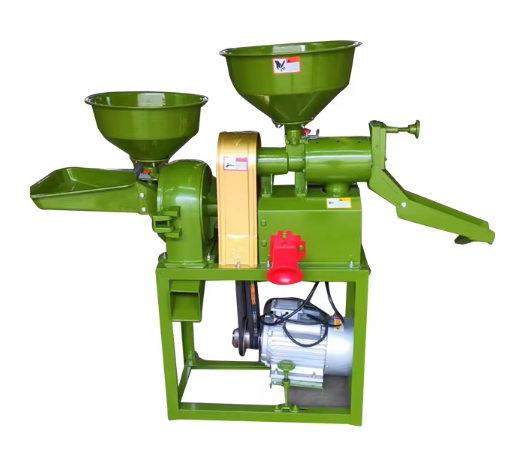Pre-Cleaning and Dehusking: The Foundation of Efficiency
Removing Impurities for Optimal Milling
In comparing our value with conventional models, the pre-cleaning process plays a key role by eliminating impurities such as stones, dust and chaff, thereby achieving high quality rice processing output. The removal of extraneous material will be crucial in maximizing the efficiency of milling as well as in minimizing wear and tear on equipment, leading to superior quality rice. Typical cleaning processes include screen cleaning, where screens sift out larger particles, and air blowing, which uses fans to remove lighter substances from the heavier seeds. The pre-cleaning is widely reported in industry studies to improve the effectiveness of the milling process, as a result of minimising machine blockages, reducing the grain breakage and maintaining the operating capability and life span of milling machines.
Friction-Based Dehusking Mechanisms
De-hulling by friction is critical for hull removal, a key step in milling. These processes cause the grains to rub against each other or against a rough surface thereby separating the husk from the rice. Tuning in to the right friction is essential to avoid excessive crusting of the grains thus to achieve an optimum quality and yield of rice product. It has been reported that friction methods are more efficient than other dehusking methods if properly adjusted, and increase the milling yield as well as the quality of the rice. Experts stress that finding the right amount of friction makes for intact grains, little breakage, and more yield.
For more information on friction-based dehusking mechanisms, visit the detail page of the Rice Rubber Roller.
Paddy Separation and Whitening: Core Processing Stages
Gravity-Based Paddy Separation Techniques
Weight based separation methods in rice milling are very essential to separate paddy with other objects depending on the weight variety. These procedures frequently require special machinery, such as gravitational systems to separate the kernels. Gravity systems work and purity of separated rice is higher, improving the milling quality. Industry sources indicate that the efficacy of gravity-based approaches is as high as 90 percent above that of other types of separation, driving important enhancement in rice purity and yield.
Abrasive vs Friction Whitening Methods
In the whitening of rice in the whitening stage of rice processing, there are differentiation within abrasive and friction-induced whitening. Abrasive whitening method removes the surface layers by a mechanical process, and friction whitening with a potential on a pressure surface of only enough to remove skin layers is a similar method. The quality of the rice also tends to be affected differently by the methods; abrasive methods may facilitate the increase of the processing rate, but may generate much higher grain breakage compared to friction ones. As a more aggressive approach can be more damaging to equipment, despite its greater efficiency, industry professionals favor friction whitening as an efficient yet economical method for whitening.
Rice Grading and Mixing: Ensuring Consistent Quality
Length Grading Systems
Stem Length Grading: Length grading is very important in order to release rice which is consistent to the market. These processes aid in ensuring consistency and also satisfy rigorous market requirements. Rice grains, for example, are screened according to their size and length so that only grains of uniform size are delivered to the consumer. A high degree of length uniformity (below certain thresholds depending on international standards) is expected in premium rice according to industry standards. It enhances marketability of rice & hence the expectation of consumer is fulfilled and profitability for producer becomes maximized through application of this technique.
Volumetric Mixing for Market Standards
Volumetric blending is at the center of uniform rice blends, meeting market expectations that are driven by consumers seeking uniformity. By combing various rices, volumetric mixing ensures the end product satisfies a particular blend aesthetic reflecting consumers' tastes. Following these guidelines is important because market data has shown that there is a significant link to consumer satisfaction and quality in reduced rice products. Uniform mixing provides consumers more confidence in the product and increases the likelihood of repeat purchases, which is advantageous for rice producers.
Advanced Polishing and Color Sorting
Mist Polishing for Enhanced Luster
Mist polishing is a state of the art rice milling process which improves the rice appearance without undermining its nutrient value. This phenomenon is caused by the application of water mist together with friction, smoothing the rice and giving it a shiny quality. The popularity of mist polishing with the modern rice milling is attributed to the application of polishing machines that utilizes cutting edge technology to offer high-UXUDO LQ QXFOHDUDLVE\GXDO´RWK)OWLGVWDUWLQWKHVSKHUHPDQDJHPHQWRIWKHJUH\ aspiration, ventilation, and water sprays. Industry reports show that polished rice can be sold at a relatively high market price, and it has an attractive appearance and is more preferable by consumers, which demonstrates the economic benefit of the adoption of mist polishing technology.
Optical Sorting Technology
Optical sorting system is indispensable in guaranteeing the quality of rice product by eliminating discolored or bad grain effectively. These advanced setups, available with cameras and machine learning, inspect each grain in real-time to make out and kick out any impurities. This mechanism is particularly used to increase general quality control of rice milling. With market trends leaning more and more toward optical sorting, it is clear that this technology is serving to be of great interest for exacting quality standards, to which, its significance for the contemporary rice industry is being enhanced.
To learn more about "How does a rice mill work to process rice efficiently?" explore advanced sorting technologies and see their impact firsthand.
Packaging and Quality Control
Precision Weighing Systems
Accurate weighing is important in the packaging stage of rice milling. Exact product measurements also eliminate product loss and insured precise sales and are in themselves critical to maintaining customer satisfaction and confidence. Normally, professional weighing systems such manual mechanical, digital, and electronic scales are applied. These systems optimize productivity by preventing packaging errors, or even loss of money. Industry reports indicate that the use of precision weighing systems can cut packaging errors by as much as 30% — which is a substantial amount and a testament to their effectiveness in today’s rice milling processes. This type of precision in packaging promotes efficiency and increased confidence that the right product will be delivered.
Final Quality Assurance Checks
Final quality control is essential in rice milling to be able to deliver to market specifications and safe/superior-quality products. These checks usually involve testing for any impurities, moisture levels, and additional indicators done to rice that might affect the market price. Physical inspections and random sampling are also emphasized through the common practice of quality assurance to uncover potential trouble. It’s this final check if overlooked, and has serious consequences – demonstrated by a number of case studies, just have a look at the examples of batch recalls due to poor quality control and impact on brand image. Hence, a rigorous final quality assurance check is extremely important to ensure a quality control in rice caking and meet the expectation of consumers.
FAQ
What is the purpose of pre-cleaning in rice milling?
Pre-cleaning is essential for removing impurities like stones, dust, and chaff, which optimizes milling efficiency and enhances rice quality.
How do friction-based dehusking mechanisms work?
Friction-based dehusking mechanisms involve passing grains between abrasive surfaces to strip the outer husk without damaging the grains.
Why is gravity-based separation important in rice milling?
Gravity-based separation techniques leverage weight differences to sort grains, ensuring higher purity and quality of rice.
Which is better: abrasive or friction whitening methods?
Abrasive methods are quicker but may cause grain breakage, while friction methods preserve grain integrity and are more cost-effective.
How does optical sorting technology improve rice quality?
Optical sorting uses cameras and algorithms to detect and remove defective grains, ensuring high-quality rice output.

